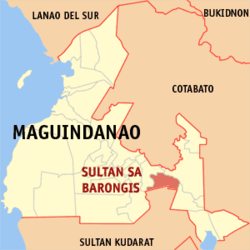Sultan sa Barongis, Maguindanao
| Sultan sa Barongis | |
|---|---|
| Municipality | |
| Municipality of Sultan sa Barongis | |
 Map of Maguindanao with Sultan sa Barongis highlighted | |
.svg.png) Sultan sa Barongis Location within the Philippines | |
| Coordinates: 6°48′N 124°38′E / 6.8°N 124.63°ECoordinates: 6°48′N 124°38′E / 6.8°N 124.63°E | |
| Country |
|
| Region | Autonomous Region in Muslim Mindanao (ARMM) |
| Province | Maguindanao |
| District | 2nd District |
| Barangays | 12 (see Barangays) |
| Government [1] | |
| • Type | Sangguniang Bayan |
| • Mayor | Datu Allandatu M. Angas |
| • Electorate | 10,267 voters (2016) |
| Area [2] | |
| • Total | 291.30 km2 (112.47 sq mi) |
| Population (2015 census)[3] | |
| • Total | 22,425 |
| • Density | 77/km2 (200/sq mi) |
| Time zone | UTC+8 (PST) |
| ZIP code | 9611 |
| PSGC | 153813000 |
| IDD : area code | +63 (0)64 |
| Climate type | Tropical climate |
| Income class | 2nd municipal income class |
| Revenue (₱) | 80,664,178.98 (2016) |
| Native languages |
Maguindanao language Tagalog |
| Website |
www |
Sultan sa Barongis, officially the Municipality of Sultan sa Barongis, is a 2nd class municipality in the province of Maguindanao, Philippines. According to the 2015 census, it has a population of 22,425 people.[3]
It is formerly known as Lambayong[4].
Barangays
Sultan sa Barongis is politically subdivided into 12 barangays.
- Angkayamat
- Barurao
- Bulod
- Darampua
- Gadungan
- Kulambog
- Langgapanan
- Masulot
- Papakan
- Tugal
- Tukanakuden
- Paldong
History
In 2004, 11 barangays of Sultan sa Barongis were transferred to the newly created municipality of Rajah Buayan, Maguindanao, reducing the number of barangays from 23 to 12.[5]
Demographics
| Population census of Sultan sa Barongis | ||
|---|---|---|
| Year | Pop. | ±% p.a. |
| 1960 | 40,347 | — |
| 1970 | 45,421 | +1.19% |
| 1975 | 17,630 | −17.29% |
| 1980 | 25,957 | +8.04% |
| 1990 | 29,916 | +1.43% |
| 1995 | 29,967 | +0.03% |
| 2000 | 34,709 | +3.20% |
| 2007 | 25,767 | −4.03% |
| 2010 | 22,547 | −4.74% |
| 2015 | 22,425 | −0.10% |
| Source: Philippine Statistics Authority[3][6][7][8] | ||
See also
References
- ↑ "Municipality". Quezon City, Philippines: Department of the Interior and Local Government. Retrieved 31 May 2013.
- ↑ "Province: Maguindanao". PSGC Interactive. Quezon City, Philippines: Philippine Statistics Authority. Retrieved 12 November 2016.
- 1 2 3 Census of Population (2015). "ARMM – Autonomous Region in Muslim Mindanao". Total Population by Province, City, Municipality and Barangay. PSA. Retrieved 20 June 2016.
- ↑ Republic Act No. 2587, Chan Robles, retrieved 2012
- ↑ National Statistical Coordination Board (2004-10-25). "2004 Factsheet (August 1-September 30, 2004)". Archived from the original on September 16, 2006. Retrieved 2006-06-24.
- ↑ Census of Population and Housing (2010). "ARMM – Autonomous Region in Muslim Mindanao". Total Population by Province, City, Municipality and Barangay. NSO. Retrieved 29 June 2016.
- ↑ Censuses of Population (1903–2007). "ARMM – Autonomous Region in Muslim Mindanao". Table 1. Population Enumerated in Various Censuses by Province/Highly Urbanized City: 1903 to 2007. NSO.
- ↑ "Province of Maguindanao". Municipality Population Data. Local Water Utilities Administration Research Division. Retrieved 17 December 2016.
External links
This article is issued from
Wikipedia.
The text is licensed under Creative Commons - Attribution - Sharealike.
Additional terms may apply for the media files.